So what is the best cherry shrimp filtration? While there are many good filters The best cherry shrimp filter is a sponge filter , hands down, it’s the best filter for a few reasons, let me explain.
, hands down, it’s the best filter for a few reasons, let me explain.
1. Sponge filters are 100% baby shrimp safe, even in power cuts shrimp can climb in and out of it and no harm will come to them as it has no moving parts.
2. it provides fantastic grazing areas for shrimplets.
3. It’s very cheap to run.
But it does have one drawback and that is because its air driven it can be a little noisy, so this filter might not be suitable for a bedroom, that is where a little power head with a sponge would shine.
Every filter has there pros and cons so for you it would all be about fulfilling your requirements.
Let me list my personal favorite filters in a Top ten format, we can then go into detail on each filter and I can give you the pros and cons on each filter based on my experience. lets go.
My Top 8 Filters for Cherry Shrimp Tanks
The filter types are:
- Sponge Filters
- Hang-on-Back (HOB) Filters
- Canister Filters
- Undergravel Filters
- Corner (Box) Filters
- Matten Filters
- Wet/Dry (Trickle) Filters
- Small Power Filters
Remember this list is based on me having a shrimp room other people might have different opinions based on their preferences and different tank locations.
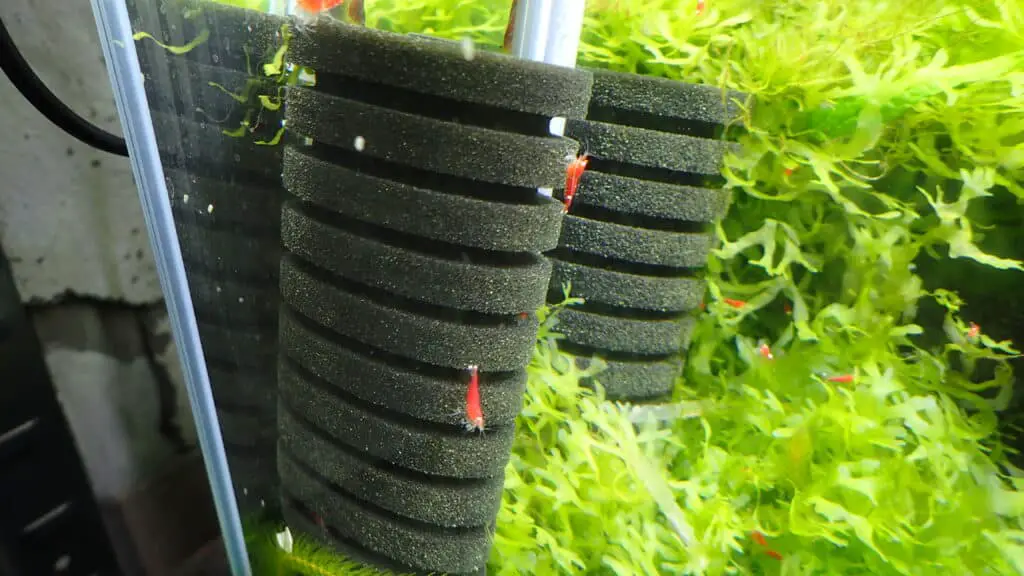
Sponge Filters for Cherry Shrimp Tanks
Sponge filters are a popular choice for cherry shrimp tanks due to their gentle water flow and ease of maintenance. They provide mechanical and biological filtration, and their sponge surface encourages the growth of biofilm, which is a vital food source for cherry shrimp.
Sponge filters are also shrimp-safe, as they prevent the shrimp and their larvae from being sucked into the filter.
| Pros | Cons |
|---|---|
| 1. Gentle water flow | 1. Limited mechanical filtration |
| Sponge filters produce a gentle water flow, which is ideal for delicate shrimp and their shrimplets. | Sponge filters may not effectively remove larger debris, requiring additional filtration methods. |
| 2. Biological filtration | 2. Aesthetically unappealing |
| The sponge material provides a large surface area for beneficial bacteria to colonize, improving biological filtration. | Sponge filters can be bulky and unattractive in the tank, taking away from the natural look. |
| 3. Safe for shrimp (no moving parts) | 3. Limited chemical filtration |
| With no strong suction or intake, and no moving parts, sponge filters are safe for shrimp and their shrimplets, reducing the risk of injury or death. | Sponge filters do not have a built-in capacity for chemical filtration, such as removing harmful chemicals or medications. |
| 4. Cost-effective | 4. Can be noisy |
| Sponge filters are generally inexpensive and can last for a long time with proper maintenance. | The air pump used to operate sponge filters can sometimes be noisy, which may be bothersome to some people. |
| 5. Oxygenation | 5. Potential for air pump failure (have a backup) |
| The air-driven design of sponge filters helps to oxygenate the water, which is beneficial for shrimp and other tank inhabitants. | Sponge filters rely on an air pump to function, so if the air pump fails, the sponge filter will also stop working. It’s essential to have a backup air pump on hand. |
| 6. Shrimp love to graze on sponge filters | |
| Shrimp enjoy grazing on the microorganisms and biofilm that grow on sponge filters, providing them with a natural food source. | |
| 7. Sponge filters provide a hiding place | |
| The sponge structure offers hiding spots for shrimp and their shrimplets, giving them a sense of security and reducing stress. | |
| 8. Easy to install | |
| Sponge filters are generally simple to set up and install in a shrimp tank, making them beginner-friendly. | |
| 9. Compatible with various air pumps | |
| Sponge filters can be used with a wide range of air pumps, giving you the flexibility to choose the one that best suits your needs. | |
| 10. Energy-efficient | |
| Sponge filters typically use less electricity compared to other types of filters, which can save you money on your energy bill. |
Note: While the table highlights general pros and cons of sponge filters in shrimp tanks, individual experiences may vary based on specific tank setups, shrimp species, and personal preferences.

Hang-on-Back (HOB) Filter for Cherry Shrimp Tanks
Hang-on-Back (HOB) filters are an efficient option for cherry shrimp tanks. They can provide mechanical, biological, and chemical filtration, depending on the filter media used.
To protect shrimp from being sucked into the intake, use a sponge or mesh pre-filter. Select a HOB filter with a gentle flow rate to ensure the shrimp’s safety.
filter with a gentle flow rate to ensure the shrimp’s safety.
| Pros | Cons |
|---|---|
| 1. Effective mechanical filtration | 1. Strong water flow |
| HOB filters efficiently remove debris from the water, helping to maintain water clarity. | The water flow from HOB filters can be strong, which might not be suitable for delicate cherry shrimp and their shrimplets. |
| 2. Chemical filtration options | 2. Risk to shrimp and shrimplets |
| HOB filters allow for chemical filtration media, such as activated carbon, which can help remove harmful substances from the water. | The intake of HOB filters can pose a risk to cherry shrimp and shrimplets if not properly covered or modified. |
| 3. Customizable media | 3. Noise |
| HOB filters provide the option to use various types of filter media, allowing for a tailored filtration system based on your tank’s needs. | HOB filters can be noisy, which may be bothersome to some people. |
| 4. Easy maintenance | 4. Uses electricity |
| HOB filters are generally easy to access and clean, making maintenance simple. | HOB filters use electricity, which can be an issue if you have multiple shrimp tanks and want to minimize power consumption. |
| 5. Suitable for larger tanks | 5. Some may fail to restart after a power outage |
| HOB filters can handle higher bioloads, making them suitable for larger tanks or tanks with more inhabitants. | Some HOB filters may not automatically restart after a power outage, requiring manual intervention. |
| 6. Surface agitation | 6. Prone to jamming |
| HOB filters help agitate the water surface, promoting oxygen exchange and preventing the buildup of harmful gases. | Debris or buildup in the impeller can cause jamming in HOB filters, affecting their performance. |
| 7. Flow is one-directional | |
| The water flow from HOB filters is generally one-directional, which may create uneven water circulation in the tank. |
Note: While the table highlights general pros and cons of Hang-on-Back filters in Cherry Shrimp tanks, individual experiences may vary based on specific tank setups, shrimp species, and personal preferences.
Make sure to adjust the flow rate or use a pre-filter sponge to protect shrimp and shrimplets from being sucked into the filter.
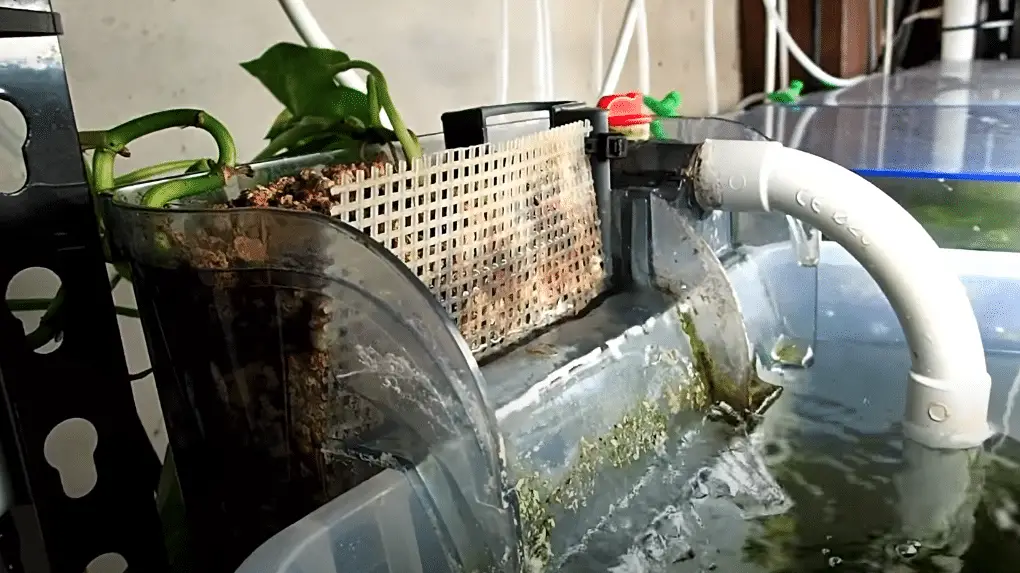

Canister Filter for Cherry Shrimp Tanks
Canister filters offer powerful and customizable filtration options for cherry shrimp tanks. They provide mechanical, biological, and chemical filtration and can handle higher bioloads.
To prevent shrimp from being pulled into the filter, use a sponge or mesh pre-filter on the intake.
| Pros | Cons |
|---|---|
| 1. Silent operation | 1. Possible leaking |
| Canister filters usually run quietly, providing minimal noise disturbance. | Canister filters can potentially leak if not properly maintained or assembled, which can lead to water damage and loss of tank water. |
| 2. Effective mechanical filtration | 2. Expensive price |
| Canister filters are efficient at removing materials from the water, maintaining water clarity. | Canister filters can be more expensive compared to other types of filters. |
| 3. Customizable media | 3. Mechanical issues |
| Canister filters allow for various types of filter media, providing a tailored filtration system based on your tank’s needs. | Canister filters may experience mechanical issues, such as a failing impeller or motor. |
| 4. Large media capacity | 4. Difficult to maintain |
| Canister filters can hold a large amount of filter media, providing more efficient filtration. | Canister filters can be more challenging to clean and maintain compared to other filter types. |
| 5. UV filter integration | 5. Requires a pre-filter |
| Some canister filters include a built-in UV filter, which can help control algae and harmful bacteria. | To protect cherry shrimp and shrimplets, a pre-filter should be added to the canister filter intake. |
| 6. Directional flow | 6. Space requirements |
| Canister filters allow for adjustable water flow direction, which can help create better water circulation in the tank. | Canister filters require additional space outside the tank for installation, which may not be suitable for all setups. |
| 7. Suitable for larger tanks | |
| Canister filters can handle higher bioloads, making them suitable for larger tanks or tanks with more inhabitants. | |
| 8. Discreet appearance | |
| Canister filters can be paired with clear tubing, making them less visible and more discreet within the aquarium setup. |
Note: While the table highlights general pros and cons of Canister filters in Cherry Shrimp tanks, individual experiences may vary based on specific tank setups, shrimp species, and personal preferences.
Make sure to use a pre-filter to protect shrimp and shrimplets from being sucked into the filter.
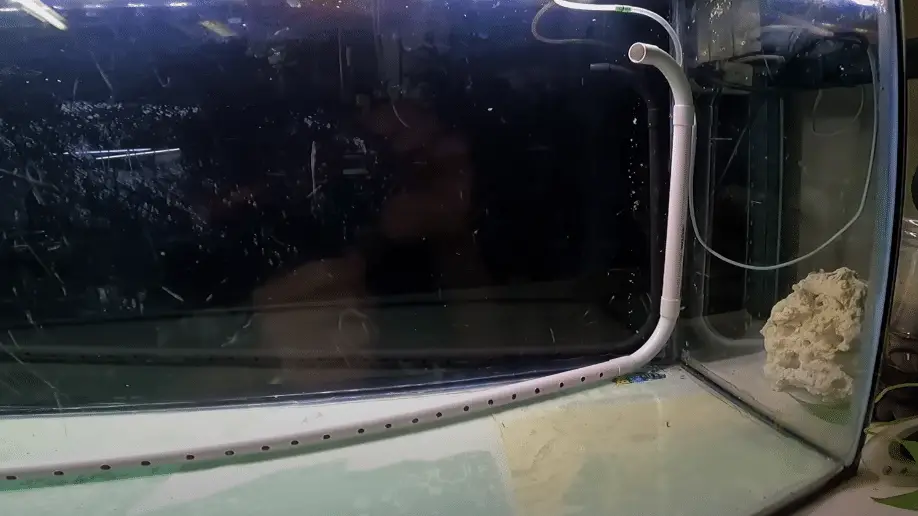
Undergravel Tanks Filter
Undergravel filters work by pulling water through a layer of substrate, providing biological filtration. This can be a suitable option for cherry shrimp tanks, but be cautious of gravel size and substrate choice to prevent trapping shrimp.
| Pros | Cons |
|---|---|
| 1. Great filtration initially | 1. Can become blocked over time |
| Undergravel filters provide effective filtration at the beginning, contributing to a clean and clear tank. | Over time, debris can accumulate in the gravel, reducing the filter’s effectiveness and requiring maintenance. |
| 2. Discreet appearance | 2. Vacuuming required |
| Undergravel filters are hidden beneath the substrate, creating a clean and natural look. | Vacuuming is necessary to remove accumulated debris, which can be harmful to shrimp in the tank. |
| 3. Energy-efficient | 3. Shrimp can get trapped |
| Undergravel filters often use air pumps, making them relatively cheap to run. | Shrimp can sometimes climb into the undergravel filter and become trapped, leading to injury or death. |
| 4. No moving parts | |
| The absence of moving parts in undergravel filters makes them less prone to mechanical failure. |
Note: While the table highlights general pros and cons of Undergravel filters in Cherry Shrimp tanks, individual experiences may vary based on specific tank setups, shrimp species, and personal preferences.
Regular monitoring and maintenance can help prevent some of the potential issues with undergravel filters.
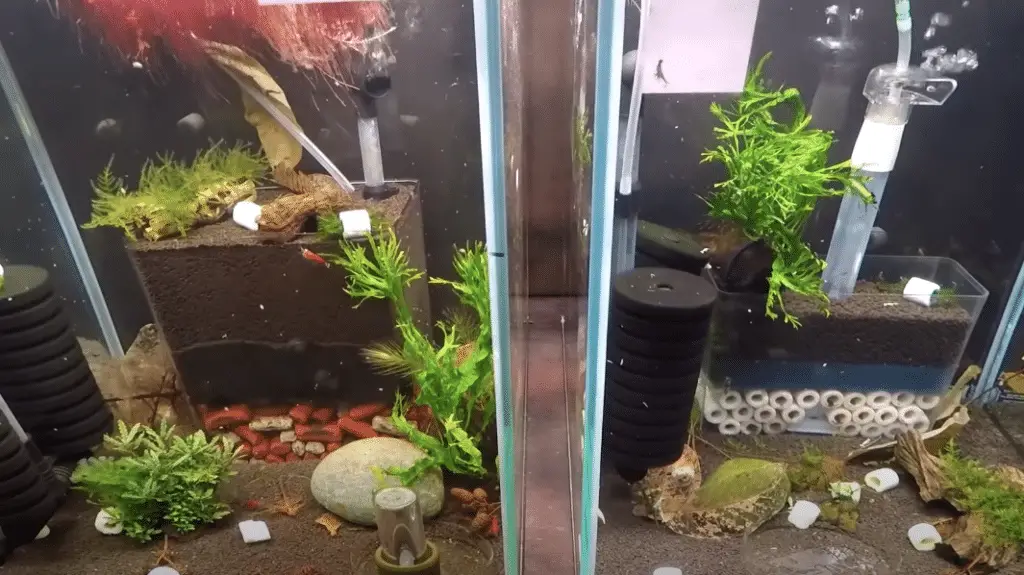
Corner (Box) Filters for Cherry Shrimp Tanks
Corner (box) filters are small, air-driven filters suitable for nano and small cherry shrimp tanks. They provide gentle filtration and can be filled with various filter media for mechanical, biological, and chemical filtration.
| Pros | Cons |
|---|---|
| 1. Customizable size | 1. Unsightly appearance |
| Corner (box) filters can be built to any size, allowing for flexibility in various tank setups. | The design of corner (box) filters can be considered unattractive and may detract from the overall aesthetic of the tank. |
| 2. Versatile media options | 2. Can be difficult to clean |
| Corner (box) filters can hold a variety of filter media, providing tailored filtration based on your tank’s needs. | Cleaning corner (box) filters can be cumbersome and time-consuming. |
| 3. Can be air-driven | 3. Shrimp can get trapped |
| Some corner (box) filters can be run on air, making them energy-efficient. | Shrimp can sometimes climb into the corner (box) filter and become trapped, leading to injury or death. |
Note: While the table highlights general pros and cons of Corner (Box) filters in Cherry Shrimp tanks, individual experiences may vary based on specific tank setups, shrimp species, and personal preferences.
Regular monitoring and maintenance can help prevent some of the potential issues with corner (box) filters.
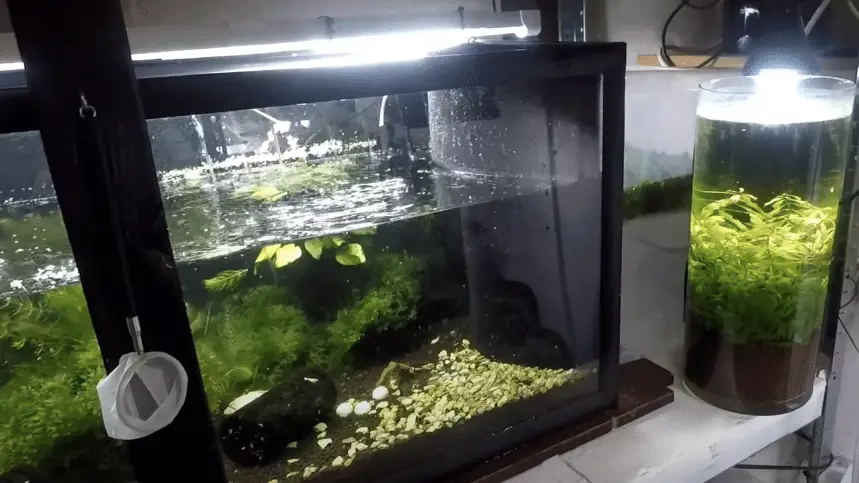
Matten Filters for Cherry Shrimp Tanks
A matten filter uses a large sheet of foam to provide mechanical and biological filtration. They are popular in cherry shrimp tanks as they offer gentle filtration and a surface for biofilm growth.
| Pros | Cons |
|---|---|
| 1. Effective filtration | 1. Difficult to clean without harming shrimp |
| Matten filters provide efficient mechanical and biological filtration, contributing to a clean and clear tank. | Cleaning matten filters can be challenging, as it often disturbs the tank and can harm shrimp. |
| 2. Safe for shrimp and shrimplets | 2. can be noisy |
| Matten filters have no moving parts, making them safe for shrimp and shrimplets. | These filters are run on air. |
| 3. Shrimp love to graze on matten filters | |
| Shrimp are attracted to the biofilm that forms on the matten filter’s surface, providing a natural food source. | |
| 4. Provides a hiding place for shrimp | |
| Matten filters offer additional hiding spots for shrimp, promoting a sense of security and natural behavior. |
Note: While the table highlights general pros and cons of Matten filters in Cherry Shrimp tanks, individual experiences may vary based on specific tank setups, shrimp species, and personal preferences. I found matten filters difficult to maintain, so it’s important to consider your own experience when choosing a filter for your shrimp tank.

Wet/Dry (Trickle) Filters for Cherry Shrimp Tanks
Wet/Dry (Trickle) filters provide excellent biological filtration and can be customized with various filter media. To use them in a cherry shrimp tank, protect the intake with a sponge or mesh pre-filter.
These filters are more commonly used in larger aquariums but can be adapted for smaller cherry shrimp tanks.
| Pros | Cons |
|---|---|
| 1. Excellent biological filtration | 1. Jamming issues |
| Wet/Dry (Trickle) filters provide superior biological filtration, promoting a healthy and stable tank environment. | Wet/Dry (Trickle) filters can experience jamming issues due to debris or mechanical failures. |
| 2. Utilizes gravity for filtration | 2. Requires a sponge pre-filter |
| These filters use gravity to move water across the surface of the biological media, increasing efficiency and reducing energy consumption. | To protect cherry shrimp and shrimplets, a sponge pre-filter should be added to the Wet/Dry (Trickle) filter intake. |
| 3. Can be noisy | |
| Wet/Dry (Trickle) filters can generate significant noise due to the water movement and potential vibrations. | |
| 4. Electrical issues | |
| Wet/Dry (Trickle) filters rely on electrical pumps, which can experience failures, impacting the filter’s performance. | |
| 5. Not a viable option for some setups | |
| Due to the potential drawbacks, Wet/Dry (Trickle) filters may not be a suitable choice for all shrimp tank setups. |
Note: While the table highlights general pros and cons of Wet/Dry (Trickle) filters in Cherry Shrimp tanks, individual experiences may vary based on specific tank setups, shrimp species, and personal preferences.
It’s essential to consider the potential issues and maintenance requirements when selecting a filter for your shrimp tank
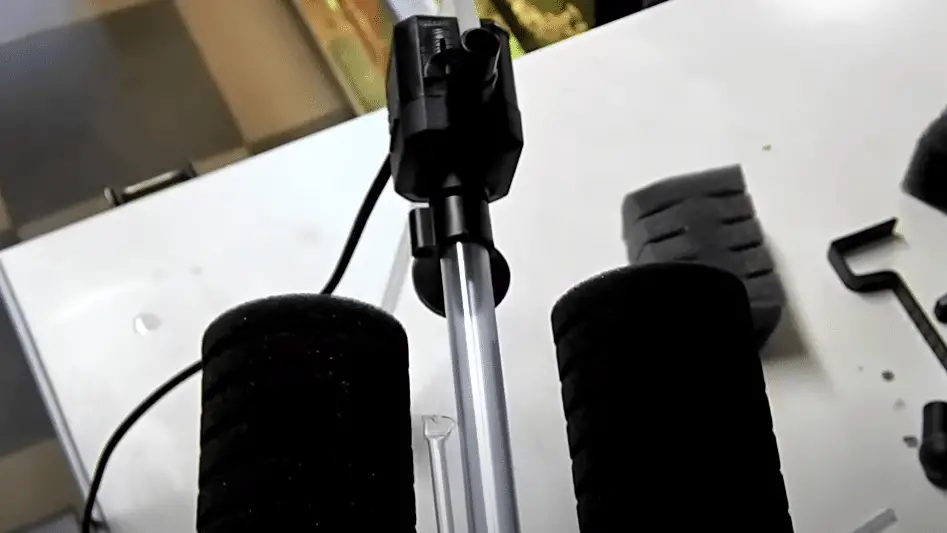
Small Power Filters for Cherry Shrimp Tanks
Small power filters, also known as mini power filters or nano power filters, are suitable for cherry shrimp tanks, providing efficient filtration for smaller tanks.
Choose a filter with a gentle flow rate to prevent shrimp from being sucked into the intake and attach a sponge or mesh pre-filter for added protection.
| Pros | Cons |
|---|---|
| 1. Small and discreet | 1. Jamming issues |
| Small Power Filters can be compact and unobtrusive, making them suitable for various tank setups. | Small Power Filters can experience jamming issues due to debris or mechanical failures. |
| 2. Quiet operation | 2. Requires a shrimp-safe pre-filter |
| Small Power Filters often run silently, making them suitable for living rooms and bedrooms. | To protect cherry shrimp and shrimplets, a shrimp-safe pre-filter should be added to the Small Power Filter intake. |
| 3. Electrical issues | |
| Small Power Filters rely on electrical pumps, which can experience failures, impacting the filter’s performance. | |
| 4. Can clog up quickly | |
| Small Power Filters, when equipped with a shrimp-safe pre-filter, can clog up quickly, requiring frequent maintenance. | |
| 5. Can increase tank temperature | |
| Small Power Filters can raise the tank temperature by a few degrees, which can be problematic in hot climates. |
Note: While the table highlights general pros and cons of Small Power Filters in Cherry Shrimp tanks, individual experiences may vary based on specific tank setups, shrimp species, and personal preferences.
It’s essential to consider the potential issues and maintenance requirements when selecting a filter for your shrimp tank.

Centralized Air Filtration System for Shrimp Breeding Rooms
In a shrimp breeding room with multiple tanks, a centralized air filtration system can be an efficient and effective solution.
This setup involves using a single, large air pump to power multiple sponge filters in various tanks. Centralized air filtration systems provide numerous benefits for shrimp breeding rooms.
Benefits of Centralized Air Filtration Systems
- Energy Efficiency: By using a single, large air pump instead of multiple smaller air pumps, you can save on energy costs and simplify your electrical setup.
- Uniform Filtration: Centralized air filtration systems can provide consistent water quality and stable conditions across all tanks in the breeding room. This uniformity can result in higher breeding success rates and healthier shrimp populations.
- Easy Maintenance: With a centralized air filtration system, you only need to maintain one air pump, making maintenance more straightforward and less time-consuming.
- Noise Reduction: Operating a single, large air pump tends to generate less noise than multiple smaller pumps, which can be particularly important in a breeding room where quiet conditions are desirable.
- Expandability: A centralized air filtration system can be easily expanded to accommodate additional tanks in your breeding room as your shrimp colony grows or if you decide to breed multiple shrimp species.
Setting Up a Centralized Air Filtration System
To set up a centralized air filtration system in your shrimp breeding room, follow these steps:
- Choose a high-capacity air pump: Select an air pump with enough capacity to provide adequate airflow to all tanks in your breeding room. The pump should be powerful enough to maintain optimal water conditions and drive the sponge filters in each tank. You want to run 1 liter of air to a 50 liter tank every minute as a guide.
- Install an air manifold: An air manifold is a device that distributes air from the central pump to multiple airlines. Install the manifold in a convenient location, ensuring that it can accommodate all the airlines running to your tanks.
- Run airlines to each tank: Connect the air manifold to each tank using airline tubing. Be sure to use check valves to prevent water from flowing back into the air pump in case of a power outage or pump failure.
- Install sponge filters in each tank: Place a sponge filter in each tank and connect it to the corresponding airline. Sponge filters are ideal for shrimp breeding rooms, as they provide gentle filtration, promote biofilm growth, and protect shrimp and their larvae from being sucked into the filter.
- Adjust airflow as needed: Use air control valves to regulate the airflow to each tank, ensuring that all tanks receive the appropriate level of aeration and filtration for optimal shrimp health and breeding success.
By implementing a centralized air filtration system in your shrimp breeding room, you can create a more efficient and effective environment for breeding and raising healthy shrimp.
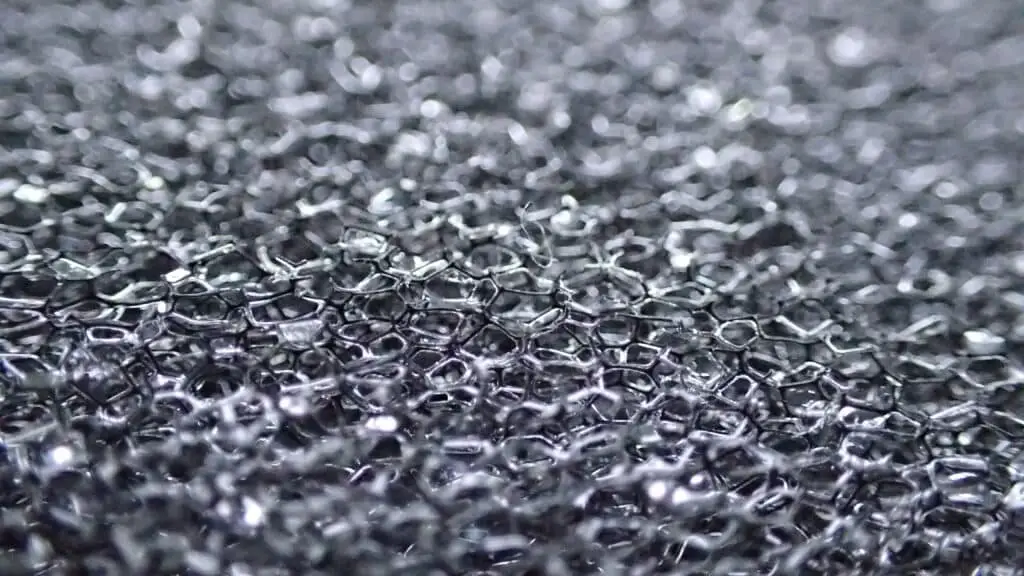
Sponge Filter Pore Size for Cherry Shrimp Tanks
When choosing a sponge filter for your cherry shrimp tank, it’s essential to consider the sponge’s PPI (pores per inch). The PPI of the sponge filter affects filtration efficiency, biofilm growth, and the safety of shrimp and their shrimplets.
Sponge Filters with Lower PPI (10-20 PPI)
Sponge filters with a lower PPI (10-20 PPI) have larger pores, which provide several benefits for cherry shrimp tanks:
- Increased biofilm growth: Larger pores can promote biofilm growth, providing an essential food source for cherry shrimp.
- Less clogging: Coarser sponges with lower PPI are less likely to clog and require less frequent maintenance.
However, sponge filters with lower PPI may not be as efficient at mechanical filtration, allowing finer particles to pass through the sponge. Additionally, the larger pores in lower PPI sponges increase the risk of trapping shrimplets.
Sponge Filters with Higher PPI (30-60 PPI)
Sponge filters with higher PPI (30-60 PPI) offer more efficient mechanical filtration due to their finer pores. These filters can effectively trap fine particles and debris from the water, ensuring clear and clean water in your shrimp tank. The benefits of using higher PPI sponge filters include:
- Effective mechanical filtration: A higher PPI sponge can effectively trap fine particles and debris, providing better water clarity.
- Increased surface area for filtration: Sponges with higher PPI have more surface area, leading to more effective filtration. However, they may clog more quickly due to the increased number of pores.
The drawback of using higher PPI sponge filters is the risk of trapping shrimplets. To ensure shrimp safety, use a sponge with a PPI of around 45 for mechanical filtration systems like power filters, as it provides a balance between filtration efficiency and shrimp safety.
In conclusion, when selecting a sponge filter for your cherry shrimp tank, consider the type of filter you are using and the PPI of the sponge.
Balancing filtration efficiency and shrimp safety will help you create an optimal environment for your shrimp and their shrimplets.

The Importance of a Backup Air Pump and Spare Parts
Having a backup air pump and spare parts on hand is crucial for maintaining a healthy and stable environment in your cherry shrimp tank.
Air pumps are essential for providing aeration, promoting gas exchange, and ensuring proper oxygen levels for your shrimp. However, equipment can fail, and having a backup plan is vital to prevent any negative consequences for your shrimp and their shrimplets.
Risks of Air Pump Failure
Relying on a single air pump without any backup or spare parts can be risky. If the air pump fails, it could lead to:
- Insufficient oxygen levels: Shrimp and other aquatic life require adequate oxygen levels to survive. A sudden drop in oxygen levels due to air pump failure can stress your shrimp and, in severe cases, lead to their death.
- Poor water circulation: Air pumps also help with water circulation, which is crucial for maintaining water quality and distributing nutrients. A malfunctioning air pump can result in poor water circulation, potentially leading to water quality issues.
Preparing for the Unexpected
To avoid the risks associated with air pump failure, it’s essential to have a backup plan:
- Backup air pump: Keep a backup air pump on hand that you can quickly set up in case your primary air pump fails. This will help maintain proper oxygen levels and water circulation in your tank while you address the issue with the primary air pump.
- Spare parts: Having spare parts for your air pump, such as diaphragms, valves, and other essential components, can be a lifesaver. If a part fails or gets damaged, you can quickly replace it and minimize any disruption to your tank’s environment.
- Temporary fixes: In case of emergencies, such as a damaged diaphragm, knowing temporary fixes like using superglue to repair the diaphragm can help you buy some time until you get a replacement part or pump. However, these temporary solutions should not be relied upon long-term, as they might not provide the same level of performance as a properly functioning air pump.
In conclusion, being prepared with a backup air pump and spare parts is critical for maintaining a healthy environment for your cherry shrimp and their shrimplets.
By planning ahead, you can minimize the risks associated with air pump failure and ensure your shrimp tank remains a safe and stable habitat.
Conclusion
After a thorough examination of various filters suitable for Cherry Shrimp Tanks, it’s clear that each filter type has its unique advantages and potential drawbacks. The best choice depends on your specific needs, the size of your tank, and the particular requirements of your shrimp species.
Sponge filters stand out for their safety, cost-effectiveness, and the beneficial grazing areas they provide for shrimplets. However, they might not be the best choice for everyone due to their potential noise level and limited mechanical filtration.
On the other hand, options like Hang-on-Back (HOB) filters, Canister filters, and Undergravel filters offer more comprehensive filtration but may require additional modifications to ensure the safety of your shrimp.
In conclusion, the best cherry shrimp filter is the one that best fits your specific needs and circumstances. It’s crucial to consider factors like filtration efficiency, safety for shrimp, noise level, and maintenance requirements when choosing a filter for your tank.
If you need any further assistance or have any questions, please don’t hesitate to reach out. Happy Shrimp Keeping!
Mark
Cherry Shrimp Filtration FAQs
Q. What is the best filter for cherry shrimp?
A. The best filter for cherry shrimp is generally a sponge filter. It’s safe for the shrimp, provides excellent biological filtration, and offers a surface for biofilm to grow, which serves as a food source for the shrimp.
Q. Do cherry shrimps need a filter?
A. Yes, cherry shrimp do need a filter. A filter helps maintain water quality by removing waste and providing necessary aeration. It also promotes the growth of beneficial bacteria, which is crucial for a healthy shrimp tank.
Q. Is hang filter good for shrimp?
A. Hang-on-Back (HOB) filters can be a good option for shrimp tanks as they offer effective mechanical, biological, and chemical filtration. However, they should be used with a pre-filter sponge to prevent shrimp from being sucked into the intake.
Q. What is the best filter for breeding tanks?
A. Sponge filters are often considered the best choice for breeding tanks. They provide gentle filtration, are safe for baby shrimp, and the sponge provides a surface for biofilm to grow, which serves as a food source for the shrimp.
Q. Do shrimps need a sponge filter?
A. While shrimp can survive without a sponge filter, it is highly recommended to use one. Sponge filters provide excellent biological filtration and a surface for biofilm to grow, which is an important food source for shrimp.
Q. Do shrimp clean sponge filters?
A. Shrimp do graze on sponge filters, eating the biofilm and microorganisms that grow on the surface. However, this should not be considered a substitute for regular filter maintenance.
Q. Which filter is best for shrimp?
A. The best filter for shrimp is generally a sponge filter due to its safety for shrimp, excellent biological filtration, and the beneficial grazing area it provides.
Q. Do shrimp need a bubbler?
A. A bubbler, or air stone, can be beneficial in a shrimp tank as it improves oxygenation and water circulation. However, if you’re using a sponge filter or another type of filter that already provides adequate aeration, an additional bubbler may not be necessary.
